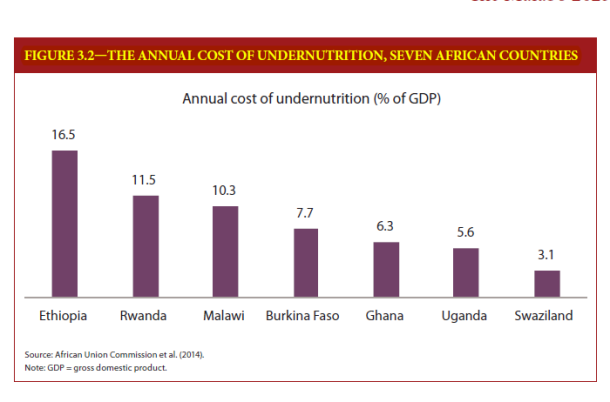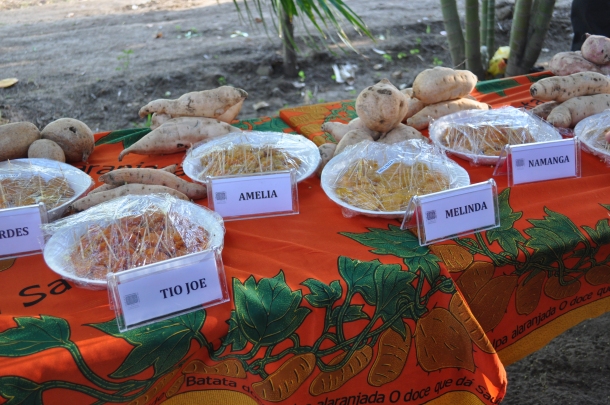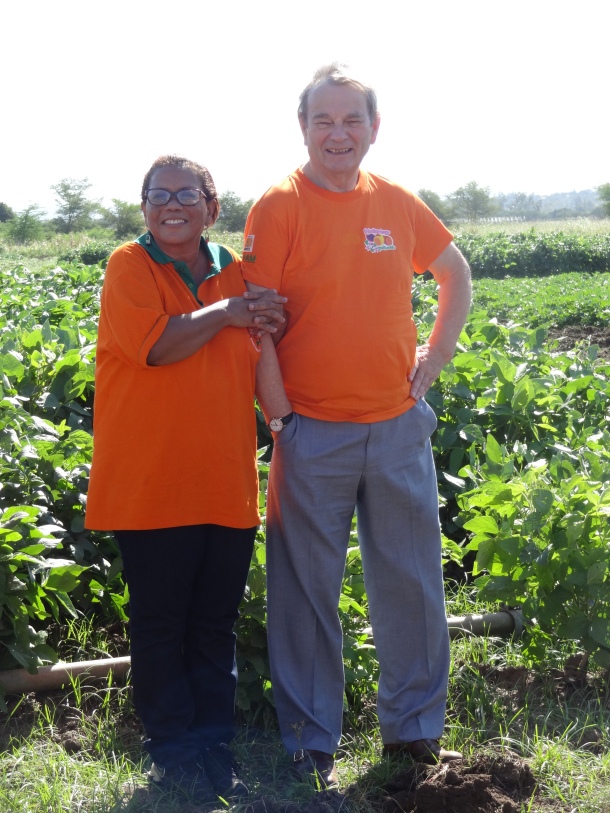by Meera Shah
Des Moines, Iowa was abuzz last week with the World Food Prize 2016 events – an annual celebration for achievements of all those working towards improving the quality, quantity and availability of food in the world.
This year, the World Food Prize recognises four distinguished individuals for developing the single most successful example of micronutrient and vitamin biofortification – the orange-fleshed sweet potato (OFSP).
 Dr. Maria Andrade (Cape Verde), Dr. Robert Mwanga (Uganda), Dr. Jan Low (the United States), all from the International Potato Centre, were recognised for developing and implementing biofortification in the orange-fleshed sweet potato. The fourth Laureate, Dr. Howarth Bouis (United States) of HarvestPlus pioneered the implementation of a multi-institutional approach to biofortification as a global plant breeding strategy.
Dr. Maria Andrade (Cape Verde), Dr. Robert Mwanga (Uganda), Dr. Jan Low (the United States), all from the International Potato Centre, were recognised for developing and implementing biofortification in the orange-fleshed sweet potato. The fourth Laureate, Dr. Howarth Bouis (United States) of HarvestPlus pioneered the implementation of a multi-institutional approach to biofortification as a global plant breeding strategy.
It is not just about the colour, however. The orange-fleshed sweet potato is a vital tool in the global fight against Vitamin A deficiency. Vitamin A deficiency is one of the leading causes of preventable blindness in children and pregnant women. Affecting between 127 million and 140 million preschool children, the World Health Organisation estimates that “between 250,000 and 500,000 vitamin A-deficient children go blind every year, half of them dying within 12 months of losing their sight.”
This deficiency also causes stunting in children. Among pregnant women, Vitamin A deficiency leads to a weakened immune system, and an increased risk of mortality from infections. HarvestPlus estimates that “(nearly) 20 million pregnant women in developing countries are also vitamin A deficient, of which about one-third are clinically night-blind”.
And yet this is a preventable situation.
Exposing ‘hidden hunger’
Globally, increasing micronutrient deficiencies are a sign of changing diets.
In order to sustain good health and development in children and normal physical and mental function in adults, micronutrients – vitamins and minerals – are crucial. Yet, more than 2 billion individuals, or one in 3 people globally, suffer from micronutrient deficiencies, often resulting in serious physical and cognitive consequences.
In many emerging economies, food consumption is shifting towards processed foods and drinks which are high in energy, but contain few micronutrients. Similarly, in developed and more urbanised countries, high fat and carbohydrate intake ‘hides’ the growing occurrence of micronutrient deficiencies. In other words, micronutrient deficiencies in developed countries manifest as overnutrition, or obesity.

On the other hand, diets in developing nations largely consist of sweet potatoes, maize, wheat, rice, and cassava, which are rich in carbohydrates, but are poor in micronutrients.
As such, micronutrient deficiencies are neither limited to developing nor developed countries. However, this form of ‘hidden hunger’ is more prevalent in developing nations than in developed nations, particularly among the poor within developing countries.
Poverty reduces the ability of households to purchase supplementary foods to diversify their diets. Instead, they are forced to consume single staple crops – potatoes, maize, wheat, rice, and cassava – which do not contain sufficient nutrients. Unfortunately, this is made worse when food prices rise, often just before harvest, during droughts and famines, or when external economic and natural shocks (e.g. earthquakes and volcanoes) impact production.
Poverty thus becomes both a cause, and outcome, of micronutrient deficiencies.
But it doesn’t stop there. Undernutrition directly affects individual wellbeing, learning and health. Eventually ‘hidden hunger’ reduces individual productivity, which in turn diminishes household income and negatively affects a country’s economic growth. According to the African Union Commission, undernutrition in Ethiopia costs a staggering 16.5% of its annual GDP.
“Let food be thy medicine and medicine be thy food.” — Hippocrates, “father of medicine”, 431 B.C.
Amongst the most commonly recognised deficiencies (iodine, iron and zinc), the public health implications of Vitamin A deficiency are worthy of attention, not least because the hardest hit are young children and pregnant women.
Animal products such as fish oils, liver, milk, eggs and butter are the primary sources of Vitamin A. Alternatively, for the vegetarians and vegans, yellow and orange fleshed fruit and vegetables and dark-green leafy vegetables contain provitamin A carotenoids, which can be converted into vitamin A by the human body. Therefore, the negative impacts of vitamin A deficiencies can be avoided by introducing targeted, simple and effective food-based interventions.
Dietary diversification, supplementation and fortification are all proven methodologies in addressing micronutrient deficiencies. However, none of them are the ‘silver bullet’ solution. Dietary diversification requires extensive nutrition education programmes and can take a long time to be transformative. Supplementation relies on continued donor support and vast infrastructure networks to reach remote communities. Equally, fortification requires strong legal systems to ensure that manufacturers comply with fortification laws.(1)
Thus biofortification offers an additional tool in addressing micronutrient deficiencies. Biofortification is the process of breeding critical vitamins and micronutrients into staple crops. Unlike conventional fortification which occurs during the processing of food, that is, after harvest, biofortification takes place earlier, through agronomic practices such as applying mineral fertilisers, (conventional) plant breeding or modern biotechnology (genetic modification).
Multiple benefits of orange-fleshed sweet potato
Sweet potatoes form a substantial and growing portion of diets across Africa. According to FAO, more than 21 million tonnes of sweet potatoes were produced in Africa in 2014, up from approximately 14 million tonnes in 2004. However, in Africa, as in many parts of Asia, the dominant variety is the traditional white variety, which contains significantly lower amounts of vitamins than its orange cousin.
Through extensive research and breeding programmes, the four winners of the 2016 World Food Prize have identified the most effective means of increasing beta-carotene content in the traditional white sweet potato. As a precursor to Vitamin A, beta-carotene – which is a plant pigment – can be easily converted into Vitamin A by human bodies. It is also the beta carotene is also what causes the bright orange colouration.

Varieties of orange-fleshed sweet potatoes in Mozambique
Just 125 grams of a fresh sweet potato root from most orange-fleshed varieties contains enough beta-carotene to provide the daily provitamin A needs of a pre-schooler. As such the orange fleshed sweet potato is the single most successful example of micronutrient and vitamin biofortification. Moreover, the new varieties are high-yielding, drought-, pest- and disease-resistant too!
Despite the obvious health and economic benefits, the new sweet potatoes were not immediately adopted by communities. They certainly looked different to what consumers were used to. Some varieties also had a different taste and texture. So, with a lot of social science, marketing and behaviour change initiatives – in addition to their work on nutrition and agriculture – these four leading scientists therefore overcame not just the technical difficulty of biofortification, but also social barriers.
By augmenting the very base foods of the poor – sweet potatoes in this case – biofortification is able to directly reach the populations where vitamin A deficiencies currently manifest highly. In 2014, 30% of Ugandan farmers were growing varieties of the orange fleshed sweet potato developed by Dr Robert Mwanga.
In addition, targeting this intervention at farmer level increases dissemination to remote areas, without the need for infrastructure investments. This approach also enhances opportunities for scaling-up through farmer-to-farmer exchanges. Indeed, after the initial investment, the costs of scale and impact fall dramatically, making it a very cost-effective intervention.
A win-win-win solution indeed!

Dr Maria Andrade with Sir Gordon Conway of Ag4Impact at an orange-fleshed sweet potato farm in Mozambique. The orange t-shirts certainly made it easier to engage with local communities!
Initiated by Dr. Norman E Borlaug, Nobel Peace Prize winner in 1970, and dubbed “the father of the Green Revolution”, the World Food Prize honours individuals who make significant and measureable contributions to improving the world food security. That these distinguished scientists have successfully reached 2 million households in Africa through which “an estimated 10 million people will avoid malnutrition and disease” is truly worthy of this high accolade.
Ag4Impact takes this opportunity to warmly congratulate all four Laureates on their achievements.









Leave a comment